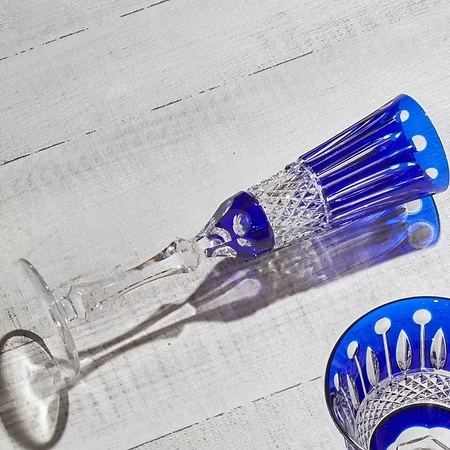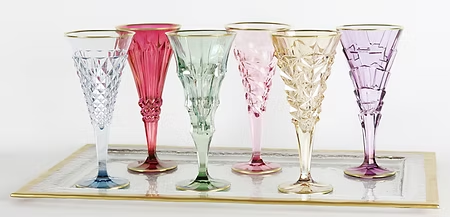Sparkling Fuel: Champagne, Sparkling Wines, and Crystal Champagne Glasses
- gpgrantswiss
- Jun 12, 2024
- 7 min read

The formula for the finest sparkling wine, discovered by Dom Pérignon in Champagne, has become humanity’s universal recipe for happiness. From Italy to India, from Spain to New Zealand, it has inspired countless winemakers to create new versions of sparkling wines, losing some of its exclusivity in the process. Paired with exquisitely crafted Crystal Champagne glasses, Champagne coupes and Champagne Flutes these wines elevate celebrations, their delicate bubbles and aromas enhanced by the artistry of fine crystal.
Despite differences in grape varieties, techniques, and terroirs, wine with bubbles has always had—and will continue to have—a magical effect on people. With that in mind, we must venture beyond Champagne to explore the enchantments this wine holds in other parts of the world.

France
When discussing French sparkling wines, it’s only fair to start with the Loire Valley—the largest producer by volume. But there’s one exception that demands attention.
In the south of France, in the heart of Languedoc, lies Blanquette de Limoux—the world’s first sparkling wine, created long before Champagne. Manuscripts from Benedictine monks in the early 16th century confirm its ancient origins. Despite this, Champagne claimed global fame. In Limoux, they proudly note that among the bottles in Thomas Jefferson’s cellar—alongside Château d’Yquem and the finest Bordeaux—sat Blanquette de Limoux, a favorite of connoisseurs on both sides of the Atlantic.
Today, Blanquette de Limoux retains its individuality: lightness, freshness, and natural elegance. Its base is the rare Mauzac grape, often blended with Chardonnay or Chenin Blanc. Neutral flavors and high acidity, with 10–12% alcohol, make Blanquette an ideal aperitif.
A special mention goes to Blanquette Méthode Ancestrale, made exclusively from Mauzac. Here, magic happens in the bottle: fermentation pauses and resumes after bottling, sometimes tied to the phases of the March full moon. The result is a semi-sweet, delicate, sparkling wine with remarkable natural purity.
Beyond Languedoc, France is renowned for its crémants—sparkling wines made using the classic method but produced outside Champagne. The term “crémant” once referred to gentler carbonation, with bubbles resembling creamy foam.
Crémant de Loire, produced around Saumur, is one of the most famous. Chenin Blanc dominates, lending vibrant acidity, floral notes, and aging potential. Major producers in the region are often subsidiaries of great Champagne houses.
Crémant de Bourgogne, made primarily from Chardonnay, is more aromatic and refined. Its stylistic similarity to Champagne gives Burgundian crémants sophistication and a recognizable character.
Crémant d’Alsace, the lightest and freshest, is mainly crafted from Pinot Blanc, occasionally with Pinot Gris or Pinot Noir. Grapes are harvested early to preserve lively acidity and airiness. This sparkling wine accounts for about 10% of Alsace’s winemaking.
Smaller volumes of crémants are also produced in Bordeaux and Jura, each region adding its own nuances to the classic formula.
Notably, Crémant d’Alsace has gained popularity as a light aperitif. Its vibrancy and purity make it the perfect start to a meal—in Alsace, serving a glass of crémant before lunch or dinner is almost a ritual of hospitality. Locals enjoy it on terraces or at family gatherings, and tourists quickly adopt the tradition.
Crémant de Bourgogne has become a trendy phenomenon in Paris and Lyon. Young wine enthusiasts choose it as a more affordable yet equally stylish alternative to Champagne. Brut Nature versions—without added sugar—are especially prized for their purity and freshness.
In Languedoc, Limoux has not only preserved its traditions but has also become a hub for biodynamic winemaking. Many estates follow organic standards, reviving ancient practices, minimizing intervention, and prioritizing nature. Blanquette de Limoux is now available in no-sulfur and unfiltered versions—truly living wines, each with a unique character.
France produces some of the finest examples of handcrafted crystal champagne flutes and champagne coupe—mouth-blown, hand-cut, and polished with exceptional attention to detail. These exquisite flutes, crafted by skilled artisans, elevate the experience of enjoying sparkling wines, allowing their aromas to unfold and delicate bubbles to shine.

Italy
Italy uses more grape varieties for sparkling wines than any other country. The famous Asti Spumante, an aromatic semi-sweet Muscat wine from Piedmont, owes its fame to the towns of Asti and Alba. Nearby lies the tiny village of Canelli, where the first examples were crafted in the late 19th century.
If a global celebration were to feature just one wine, Asti Spumante would be a strong contender. Why? First, it’s the third most popular sparkling wine after Champagne and Cava. Second, this frothy (spumante means “sparkling”) wine with a touch of sweetness has a magical effect on women’s moods—and thus on men’s. Third, it’s light, with only 7–9% alcohol, allowing carefree enjoyment. It’s also versatile, pairing well as an aperitif, with appetizers, cheeses, fruits, or desserts. Finally, its affordability makes it ideal for large gatherings.
Though Muscat is one of Piedmont’s oldest grapes, its sparkling version is relatively recent. Carlo Gancia pioneered the Champagne method for local grapes in the 1870s. Today, Asti is made differently: secondary fermentation occurs in large sealed tanks, and the wine is released quickly to preserve its freshness and vibrancy. The best Asti Spumante avoids cloying sweetness, captivating with natural fruitiness reminiscent of ripe peaches and apricots.
While Asti Spumante is the soul of grand celebrations, Moscato d’Asti is for intimate family gatherings. Made in small batches from select grapes, it’s light, elegantly sweet, and subtly fruity, with a maximum of 5.5% alcohol by law. It’s not a spumante but a delicate frizzante—lightly sparkling. Bottles are sealed with standard corks and served in white wine glasses. In Piedmont, it’s a traditional Christmas drink.
Another intriguing Piedmontese wine is the red Brachetto, made from Nebbiolo and Barbera. Dramatic in character, it bursts with sweet strawberry and red berry flavors. Typically paired with fruits, locals also enjoy it with sausages.
Rivaling Asti Spumante in popularity is Prosecco. Outside Italy, Prosecco is rapidly gaining fame, with dedicated “prosecco bars” popping up in major cities. Named after its grape, Prosecco is centered in the towns of Conegliano and Valdobbiadene, with the prestigious Cartizze vineyard—a mere 100 hectares among over 4,300—standing out.
Once a soft, slightly sweet, barely sparkling wine, Prosecco is now often dry and full-bodied. Secondary fermentation in tanks preserves bright fruit and floral aromas without yeasty notes. Italians drink Prosecco from 10 a.m. onward, and in Venice, at any time of day. The Bellini cocktail, blending white peach and Prosecco, was invented there.
Italy’s traditional crystal craftsmanship—mouth-blown, hand-cut, and polished—blends with modern technology to create refined, contemporary Crystal Champagne flutes and copes. These elegant flutes, crafted with precision, enhance the enjoyment of sparkling wines, preserving their vibrant bubbles and revealing their intricate aromas.

Spain
When it comes to sparkling wines beyond Champagne, Cava is the first that comes to mind. A hallmark of Catalonia since 1872, it remains a key rival to Champagne.
Cava is made using the traditional method of secondary fermentation in the bottle (método tradicional), like Champagne, but primarily with native grapes: Macabeo, Xarel·lo, and Parellada. The result is a wine with vibrant freshness, notes of green apple, citrus, white flowers, and subtle almond hints.
Most Cava hails from the Penedès region in Catalonia, near Barcelona, though production has expanded across Spain, from Aragon to Valencia. The finest examples still come from traditional areas.
Cava is categorized by aging:
Cava (minimum 9 months on lees)
Cava Reserva (minimum 18 months)
Cava Gran Reserva (minimum 30 months)
Cava de Paraje Calificado (vintage Cava from a single exceptional plot, minimum 36 months)
Extended aging gives top Cavas complexity, with notes of toast, nuts, and brioche, akin to fine Champagne.
In recent years, Spain has seen a push for quality: organic and biodynamic Cavas have emerged, with many estates adopting hand-harvesting and minimal intervention.
Cava’s versatility makes it ideal for tapas, fish, or white meat dishes. Spaniards believe no occasion—from a casual aperitif to New Year’s Eve—is complete without a glass of good Cava.

Old and New World: Sparkling Discoveries
Germany
German sparkling wine, known as Sekt, is mostly light, tank-fermented, but top producers use the classic method. Premium Sekt, often made from Riesling, emphasizes lively fruitiness and crisp acidity. Wines from estates like Ratzenberger in Mittelrhein shine with freshness, thanks to limestone-clay soils.
South Africa
In Stellenbosch and Franschhoek, South African winemakers excel at Méthode Cap Classique (MCC), Champagne-style sparkling wines. Light, mineral-driven, with citrus and white flower notes, top MCCs are gaining international acclaim, perfect for summer aperitifs or romantic dinners against African sunsets.
США
California produces world-class sparkling wines in Napa and Sonoma. Brut wines from Domaine Chandon, Schramsberg, and Roederer Estate blend classic methods with California’s bold flavors, offering aromas of baked apple, pear, and subtle almond. They’re often brighter and fresher than European counterparts, ideal for New World cuisine.
Australia
Australia is famous for its unique Shiraz-based sparkling wines, bursting with blackberry, spice, and chocolate. Yet, classic white bruts from cool-climate Tasmania are equally compelling, with fresh, mineral-driven profiles, crisp acidity, and lingering finishes.
Chile
Chilean winemakers in Casablanca and Limarí are crafting quality sparkling wines with clean flavors, high acidity, and fruit-forward profiles. Muscat yields aromatic, off-dry wines, while Chardonnay and Pinot Noir produce elegant bruts with green apple and citrus notes.
England
English sparkling wines from Sussex, Kent, and other southern counties are a revelation, rivaling Champagne. Crisp acidity, pronounced minerality, and pure green apple and white flower aromas define them. Regularly awarded at global competitions, they’re a new symbol of elegance and quality.
Argentina
Argentina’s sparkling wines are a key part of its wine industry, with success driven by renowned Champagne houses. Known for vibrant fruitiness, richness, and affordability, they’re a standout in the New World.
The Finest Sparkling Wines Deserve the Finest Crystal Crystal Champagne Glasses, Champagne Coupes and Champagne Flutes
Crafting great sparkling wines demands skill, patience, and respect for tradition. Equally important is presenting them with dignity.
For true connoisseurs of style, we offer our exclusive collection of handcrafted crystal Champagne glasses.
Each flute is meticulously crafted by skilled artisans from premium crystal. Their elegant shape allows the wine to fully reveal its aroma, preserve delicate bubbles, and highlight its vibrancy.
A perfect union of tradition and modern taste—like the world’s finest sparkling wines.






























































